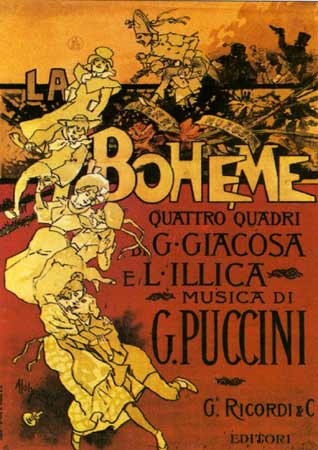Composer Giacomo Puccini
(Photo credit: Wikipedia)
Puccini's opera La Boheme is one of the most popular and loved pieces. It will sell out at opera houses around the world many times over. It seems opera lovers simply can't get enough of this work. Why is it?
Perhaps the story of love at first sight and the simply stunning music are two things that make it so popular. The story is one that many people can relate to. It is about real human emotions and situations rather than fairies and emotionally out of touch characters.
Most aspiring professional opera singers have one of the many arias from La Boheme on their wish list. Most characters have one or two outstanding songs which is also why you will often hear arias as well as duets from La Boheme sung at opera galas of popular opera.
What is the story then? La Boheme is an opera in four acts based on a story of bohemian life set in the Latin Quarters in Paris in the 1840s. The world premiere was in Turin in 1896 and was conducted by a young Arturo Toscanini. Toscanini would later become one of the most well-known and highly regarded conductors of opera of all time. It was an instant hit and immediately became part of the standard opera repertoire.
 |
| Poster for Puccini's La bohème Artist: Adolfo Hohenstein (1854-1928) (Photo credit: Wikipedia) |
The beginning of the opera sees four men in an attic space. There is Marcello (a baritone) who paints, the writer Rodolfo (a tenor), Colline (a bass) who is a philosopher, and the musician Shaunard (a baritone). They have very little or no money and in order to keep warm, they burn one of Rodolfo's failed manuscripts. The three men go out to Café Momus around the corner and Rodolfo will join them later after having finished the article he is writing. There is a knock on the door and Mimi (a soprano), a seamstress who also lives in the building, enters. She asks Rodolfo if he has any matches as her candle has blown out. This is the start of their great love story and it is where we hear two of the most famous arias ever written. First, there is Rodolfo's aria Che gelida manina (What a cold little hand) followed by Mimi's Si, mi chiamano Mimi (Yes, they call me Mimi) where they tell each other of their backgrounds and interests. This leads into one of the most well-known duets in the entire operatic repertoire, namely O soave fanciulla (Oh gentle maiden). The melodies are beautiful and the music is thick and bursting with emotion. There is something so simple and human about the love between Rodolfo and Mimi.
Act two starts with the four men and Mimi at Café Momus in the Latin Quarters. Soon, there is quite some commotion and a very elegant and sexy woman enters the scene. This is Musetta (another soprano), the former girlfriend of Marcello. She is now with an old rich man, Alcindoro (a bass) and it is quite clear she is fed up with him. When she sees Marcello she starts singing another aria which is one of the most popular ones ever written called Quando m'en vo (When I walk along) to make him jealous. In this very risque aria, she talks about how walking down the street everyone admires her and thinks she is amazing. Act two ends with a great ensemble in which Rodolfo and Mimi, and the now reunited couple of Marcello and Musetta, are singing together.
At the start of act three, Mimi is seen wandering the streets looking for Marcello whilst coughing severely. Rodolfo has left her and she is bereft. Later on, Mimi overhears Rodolfo telling Marcello that he left Mimi because he is afraid she is dying and he can't cope with it as he has no money to pay for doctors or medicine for her. He hopes she will find a rich man who can give her what he can't. Mimi's coughing reveals her presence and the two unite again for the time being. Here Mimi sings her second aria Donde lieta usci (From here she happily left), and soon after this Musetta arrives and is seen arguing passionately with Marcello. There is a very funny quartet where the two couples and singing together; the one couple reconciled and full of love, and the other one fighting and calling each other quite hateful words.
The final act sees the action back in the attic room from the start of the opera where Rodolfo and Marcello both mourn the loss of their respective lovers leaving them. Soon Musetta arrives with Mimi whom she found wandering around in the streets severely ill. Musetta and Marcello leave to sell Musetta's earrings in order to be able to afford medicine for Mimi. Here in the finale of this fantastic masterpiece of an opera, Rodolfo and Mimi recall their first meeting and their happiness together. Mimi dies in Rodolfo's arms and the opera ends with Rodolfo's crying out Mimi's name in anguish as he weeps uncontrollably. It is one of the most dramatic and heart-wrenching endings of all time. You can feel the despair and loss of Rodolfo and the sadness of all the friends who have arrived back in the attic room just as Mimi dies.
|


